Welcome to the fascinating world of green birds in Michigan! These birds are some of the state’s most beautiful and diverse species.
Green birds are the third most common type in Michigan, behind sparrows and robins.
From the bold and bright Scarlet Tanagers to the delicate and mysterious Golden-winged Warbler, there are a variety of species to explore.
This guide will provide an overview of Michigan’s different types of green birds and what makes them special.
22 Green Bird Species You Can Spot in Michigan
In Michigan, various green-hued birds can be observed across its diverse habitats, from dense forests to wetlands and urban areas.
Here’s a list of 22 birds with green coloration you might find in Michigan, keeping in mind that the extent of green can vary among species, from vivid greens to more subdued olive or greenish-yellow tones:
1. Ruby-Throated Hummingbird
The ruby-throated hummingbird is a species of hummingbird that is found in many parts of the Americas. The bird is usually found in Central America, Mexico, and Florida during the winter.
During the summer, however, it migrates north to Canada and other parts of Eastern North America to breed.
This remarkable species of hummingbird has adapted to its environment by having a migratory pattern that allows it to take advantage of the warmer climates for the winter and the cooler climates for the summer.
The ruby-throated hummingbird is an incredible example of adaptation and survival in the wild.
| Kingdom | Animalia |
| Phylum | Chordata |
| Clade | Strisores |
| Class | Aves |
| Order | Apodiformes |
| Family | Trochilidae |
| Genus | Archilochus |
| Species | A. colubris |
2. Green Heron
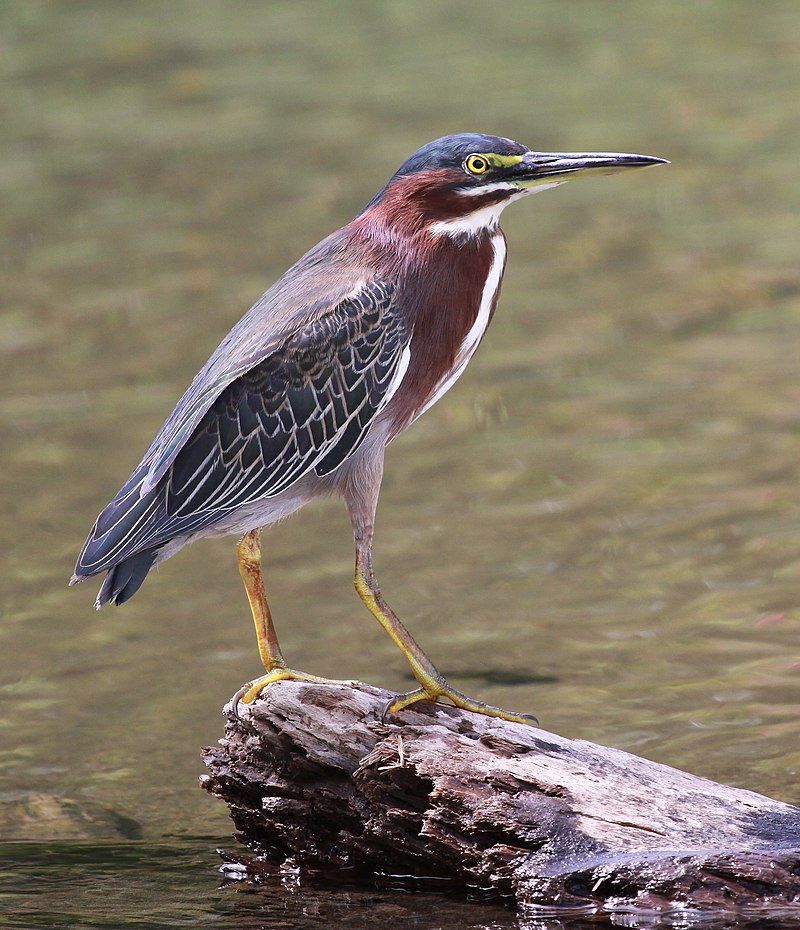
The green heron is a small wading bird species in North and Central America. It is scientifically known as Butorides virescens and is the only member of its genus.
The species name is derived from Middle English butor, meaning “bittern,” and Ancient Greek -oides, meaning “resembling”. The species name virescens is Latin for “greenish.”
Green herons typically have a dark olive green with a chestnut neck and white or pale gray underparts. They have long legs that help them wade in water and a long, pointed bill that aids in catching prey.
They are usually found near water, such as streams, marshes, and ponds, and they feed on fish, frogs, insects, and small reptiles. Green herons can be seen standing still on the edge of a body of water, waiting for prey to come their way.
They are also known to stand in water and wait for prey to come to them.
| Kingdom | Animalia |
| Phylum | Chordata |
| Clade | Dinosauria |
| Class | Aves |
| Order | Pelecaniformes |
| Family | Ardeidae |
| Genus | Butorides |
| Species | B. virescens |
3. Mallard
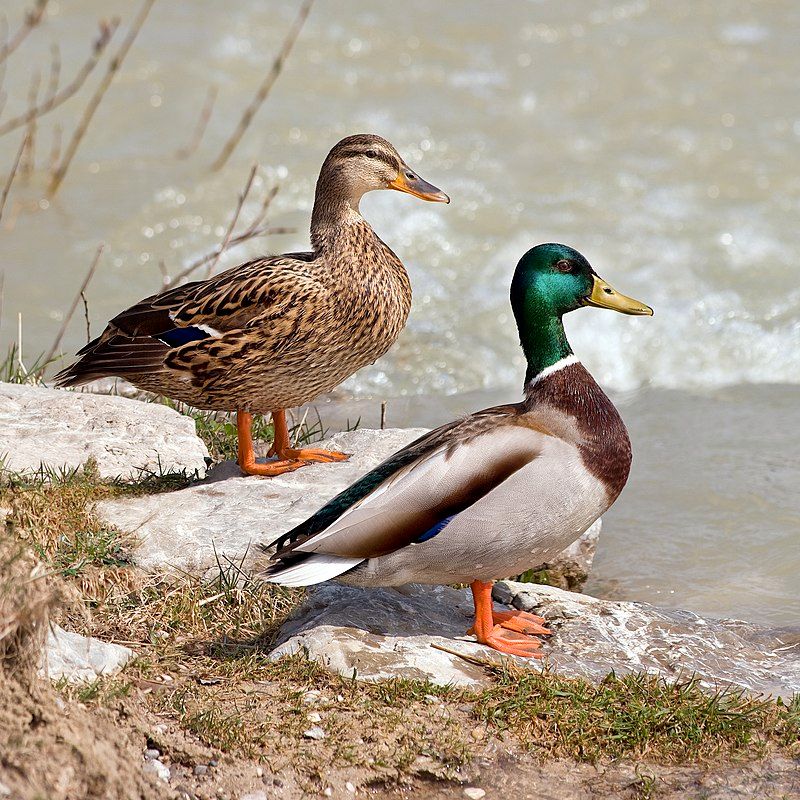
The mallard, also known as the wild duck, is a species of dabbling duck widely distributed worldwide. It is native to the Americas, Eurasia, and North African temperate and subtropical regions.
This species has been introduced to many other parts of the world, such as New Zealand, Australia, Peru, Brazil, Uruguay, Argentina, Chile, Colombia, the Falkland Islands, and South Africa.
This has been done for various reasons, such as to provide a food source or for recreational activities. Mallards are common in many areas, with their bright green-head and brown body.
They are generally quite social birds, living in large flocks containing hundreds of individuals. These flocks help protect against potential predators and provide a larger food source.
Mallards are omnivores, meaning they eat various foods, such as small fish, insects, plants, and seeds. They typically forage near shallow waters, using their specialized bill to filter food from the water.
Mallards are an important species in many habitats, as they help to disperse seeds and regulate insect populations. They are also popular game birds, with many hunters pursuing them for their meat and feathers.
Mallards are also popular among birdwatchers, who appreciate their bright colors and unique behaviors.
| Kingdom | Animalia |
| Phylum | Chordata |
| Clade | Dinosauria |
| Class | Aves |
| Order | Anseriformes |
| Family | Anatidae |
| Genus | Anas |
| Species | A. platyrhynchos |
4. Eurasian Teal
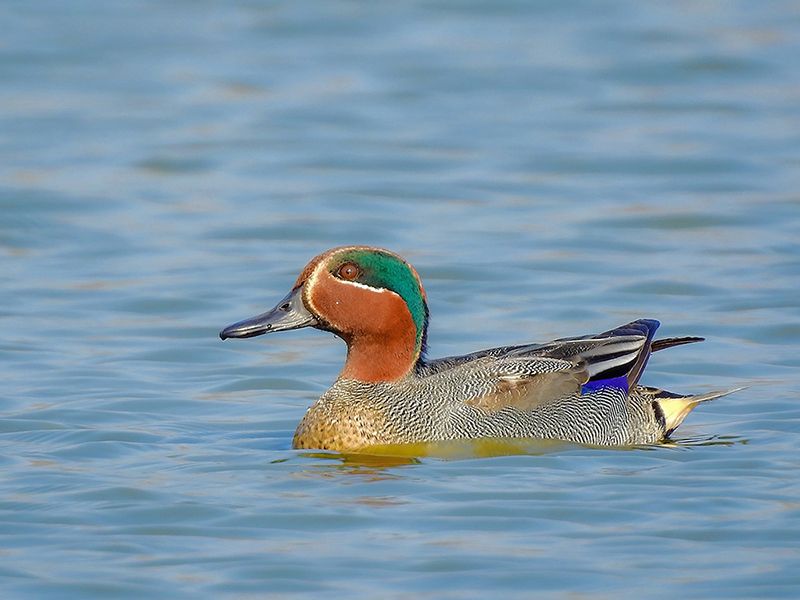
The Eurasian teal is a small, dabbling duck widely distributed across temperate parts of Eurasia. It is commonly referred to as the common teal or Eurasian green-winged teal and is the only one of its kind found in much of its range.
During the summer breeding season, the Eurasian teal inhabits parts of Eurosiberia, where it nests and raises its young. As winter approaches, the teal migrates south to warmer regions to find food and suitable habitat for the cold months.
The Eurasian teal is an adaptable species, able to take advantage of changing environments to ensure its survival. It is also a popular duck among birdwatchers and hunters alike due to its attractive plumage and willingness to stay close to humans.
| Kingdom | Animalia |
| Phylum | Chordata |
| Clade | Dinosauria |
| Class | Aves |
| Order | Anseriformes |
| Family | Anatidae |
| Genus | Anas |
| Species | A. crecca |
5. New World Warblers
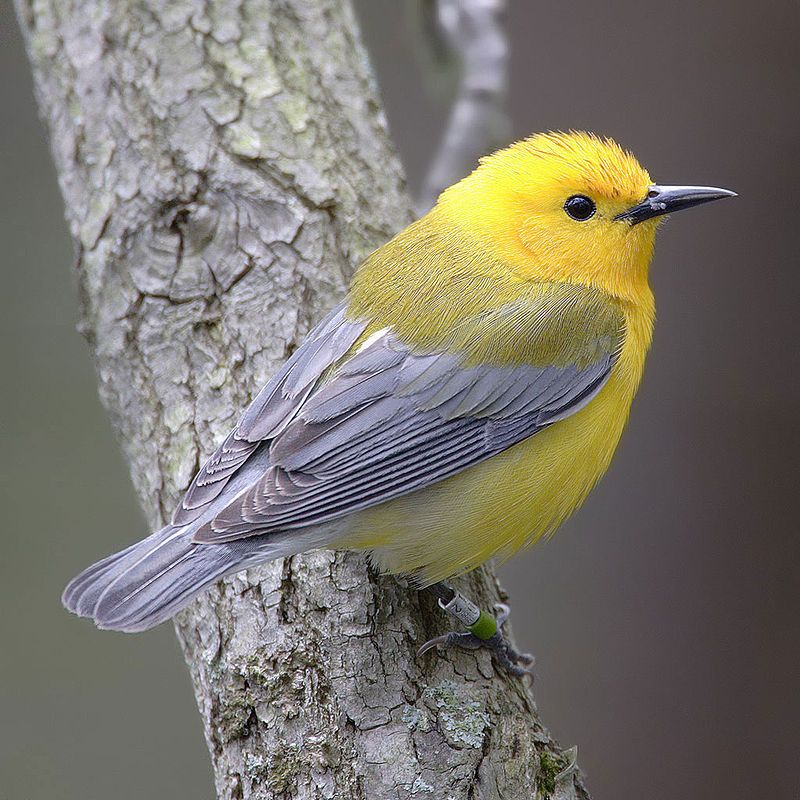
The New World warblers are a family of birds commonly referred to as wood-warblers. These birds are small, vibrant, and belong to the Parulidae family. They are only found in the New World and are not closely related to birds in the Old World or Australia.
These birds are known for their colorful feathers and cheerful chirping, making them a delight to watch in any setting. The Parulidae family is divided into two subfamilies: the wood-warblers and the waterthrushes.
The wood-warblers are smaller than the waterthrushes and typically have brighter coloration. They can be found in various habitats, from shrubby woodlands to open grasslands.
Their diet consists of insects, fruit, and seeds, which they forage for in vegetation or on the ground. The Old World and Australian warblers are members of different families and are not closely related to the New World warblers.
The Old World warblers are part of the Sylviidae family, while the Australian warblers are part of the Acanthizidae family.
Each bird family has unique characteristics and behaviors, distinguishing them from the New World warblers. The New World warblers are a small, vibrant family of birds found only in the New World.
Although they are not closely related to birds in the Old World and Australia, they have unique characteristics and behaviors. These birds are a delight to watch and add color and life to the environment.
| Kingdom | Animalia |
| Phylum | Chordata |
| Clade | Dinosauria |
| Class | Aves |
| Order | Passeriformes |
| Family | Parulidae |
6. Green-Winged Teal
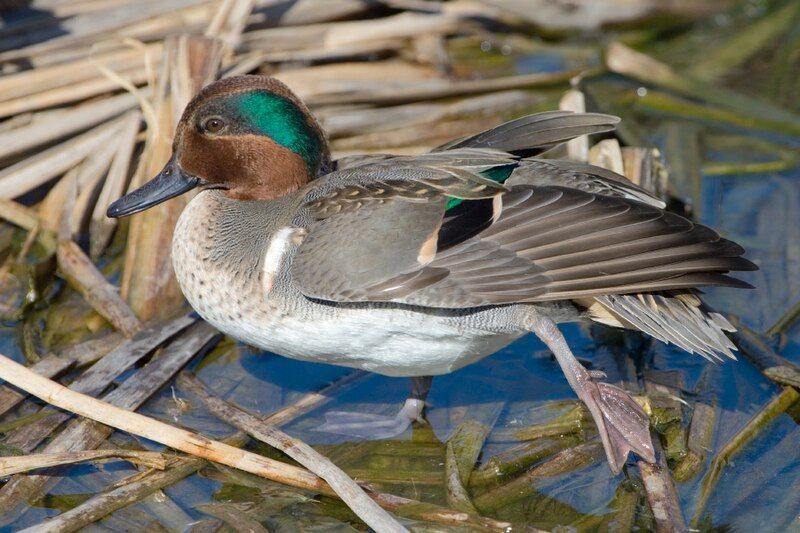
The American teal is a species of duck found across North America, excluding the Aleutian Islands. It is also called the green-winged teal due to its distinctive greenish wings.
This duck species is widespread, occupying various habitats, from wetlands to wooded areas. The American teal was considered the same species as the Eurasian teal for some time.
However, further research has shown that they are separate species, and the American teal is now recognized as its species. This is due to differences in physical characteristics, such as their plumage color, behavior, and habitat preferences.
The American teal is particularly well adapted to cold climates and will breed in northern North America, while the Eurasian teal prefers wetter habitats in the south.
| Kingdom | Animalia |
| Phylum | Chordata |
| Clade | Dinosauria |
| Class | Aves |
| Order | Anseriformes |
| Family | Anatidae |
| Genus | Anas |
| Species | A. carolinensis |
7. Pine Warbler

The pine warbler is a small songbird from the New World warbler family. It is native to North America and is found in large numbers in coniferous and mixed forests. It is a rather plain-looking bird, with gray-brown upperparts and yellow underparts.
The male is slightly more brightly coloured than the female. Its song is a series of notes delivered in a pleasing, melodic style. The pine warbler feeds mainly on insects and can often be seen foraging among the branches and foliage of trees.
It is also known to eat some fruit and seeds. It nests in trees, constructing a cup-shaped nest of twigs, grasses, and rootlets. The female lays three to five eggs and incubates them for 12 to 13 days.
The pine warbler is an adaptable species, and its numbers are increasing in many areas. This is due to various factors, including the spread of urban areas, which provide abundant food and nesting sites.
The Migratory Bird Treaty Act also protects the species, making hunting, capturing, or killing them illegal.
| Kingdom | Animalia |
| Phylum | Chordata |
| Clade | Dinosauria |
| Class | Aves |
| Order | Passeriformes |
| Family | Parulidae |
| Genus | Setophaga |
| Species | S. pinus |
8. Red-Eyed Vireo
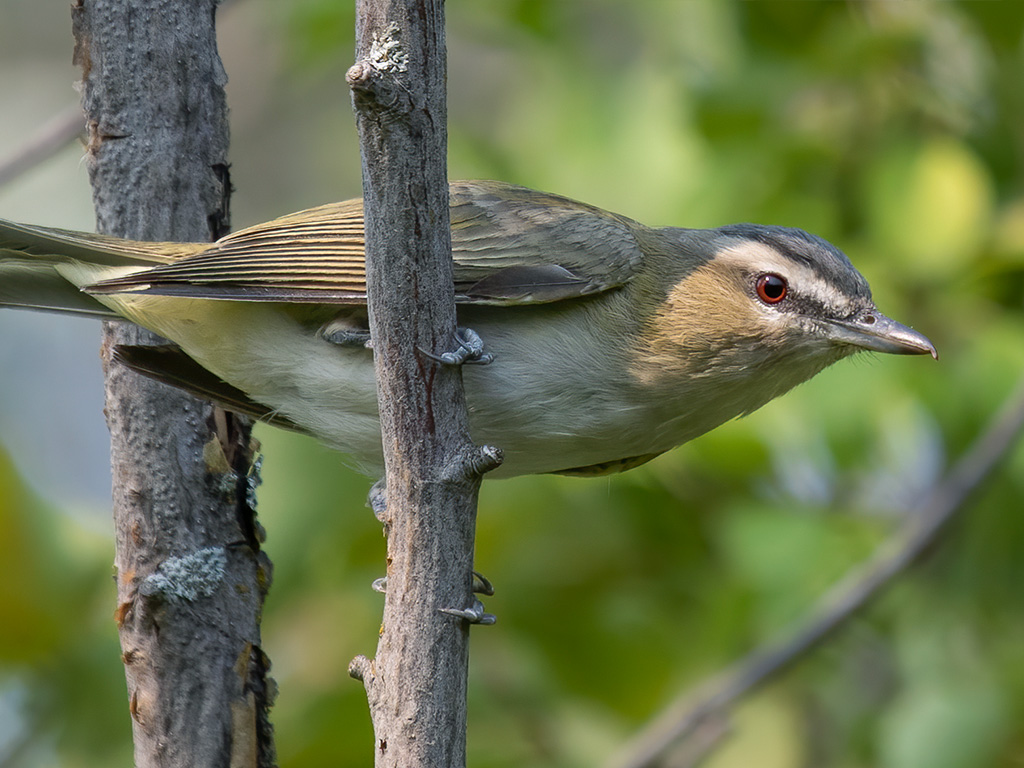
The red-eyed vireo is a small American songbird native to the continent. It belongs to the Vireonidae family, a group of birds not closely related to the New World warblers, although they share similar characteristics.
The red-eyed vireo is found in various habitats across North America, from the boreal forests of Canada to the tropical areas of Mexico and Central America.
This species is common across its extensive range and is not considered threatened by the International Union for Conservation of Nature (IUCN).
The IUCN categorizes the red-eyed vireo as a species of least concern, meaning that it is not facing a significant risk of extinction shortly. This species is a popular bird-watching target due to its vibrant plumage and melodic song.
| Kingdom | Animalia |
| Phylum | Chordata |
| Clade | Dinosauria |
| Class | Aves |
| Order | Passeriformes |
| Family | Vireonidae |
| Genus | Vireo |
| Species | V. olivaceus |
9. Black-Throated Green Warbler
The black-throated green warbler is a small, migratory songbird that belongs to the warbler family. This bird species is found in eastern North America and Central America. It is known for its bright green plumage and black throat patch.
The males are the most vocal of the species, singing a flirty, melodious song. They also have a distinctive white eye stripe. In the summer, the black-throated green warbler can be found in mature deciduous forests, mixed woodlands, and other wooded areas.
During winter, they migrate south to Central America to the Caribbean. These birds feed mainly on insects, such as caterpillars, beetles, and ants. They also eat some fruit, seeds, and nectar.
Their diet is supplemented by suet, made from birdseed and fat. The black-throated green warbler is an important species of bird in North America. They are a key pollinator and help support the health of our forests.
They are listed as a species of least concern by the International Union for Conservation of Nature. Still, their population has declined over the last few decades due to habitat loss and degradation.
Conservationists are working to protect their habitats and increase their populations.
| Kingdom | Animalia |
| Phylum | Chordata |
| Clade | Dinosauria |
| Class | Aves |
| Order | Passeriformes |
| Family | Parulidae |
| Genus | Setophaga |
| Species | S. virens |
10. Ruby-Crowned Kinglet
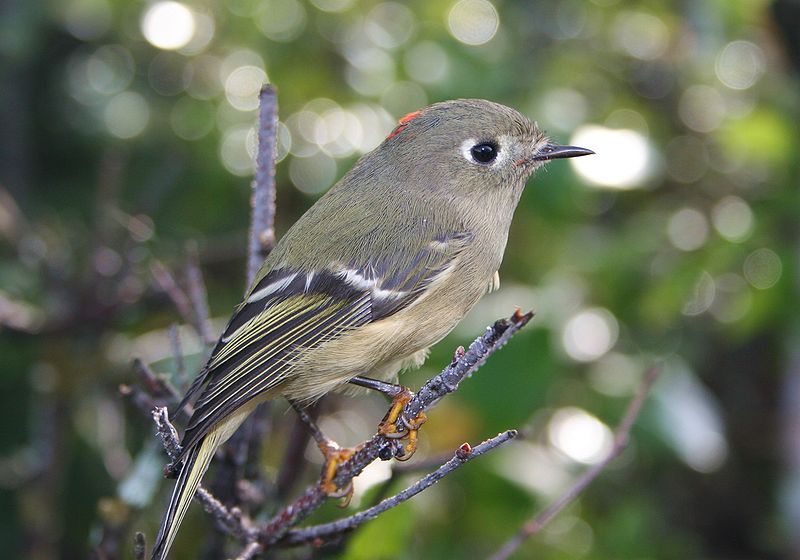
The ruby-crowned kinglet is a very small passerine bird found throughout North America. It belongs to the kinglet family, which consists of small, insectivorous birds. Its plumage is olive-green, with two white wing bars and a white eye ring.
The most distinctive feature of the ruby-crowned kinglet is the red crown patch found on the males. This patch is usually hidden and only revealed when the bird is agitated or singing.
The ruby-crowned kinglet is a very active bird, usually foraging in the treetops for small insects. It is a common sight in forests across its range and is often heard singing its high-pitched, tinkling song.
| Kingdom | Animalia |
| Phylum | Chordata |
| Clade | Dinosauria |
| Class | Aves |
| Order | Passeriformes |
| Family | Regulidae |
| Genus | Corthylio |
| Species | C. calendula |
11. Berylline Hummingbird
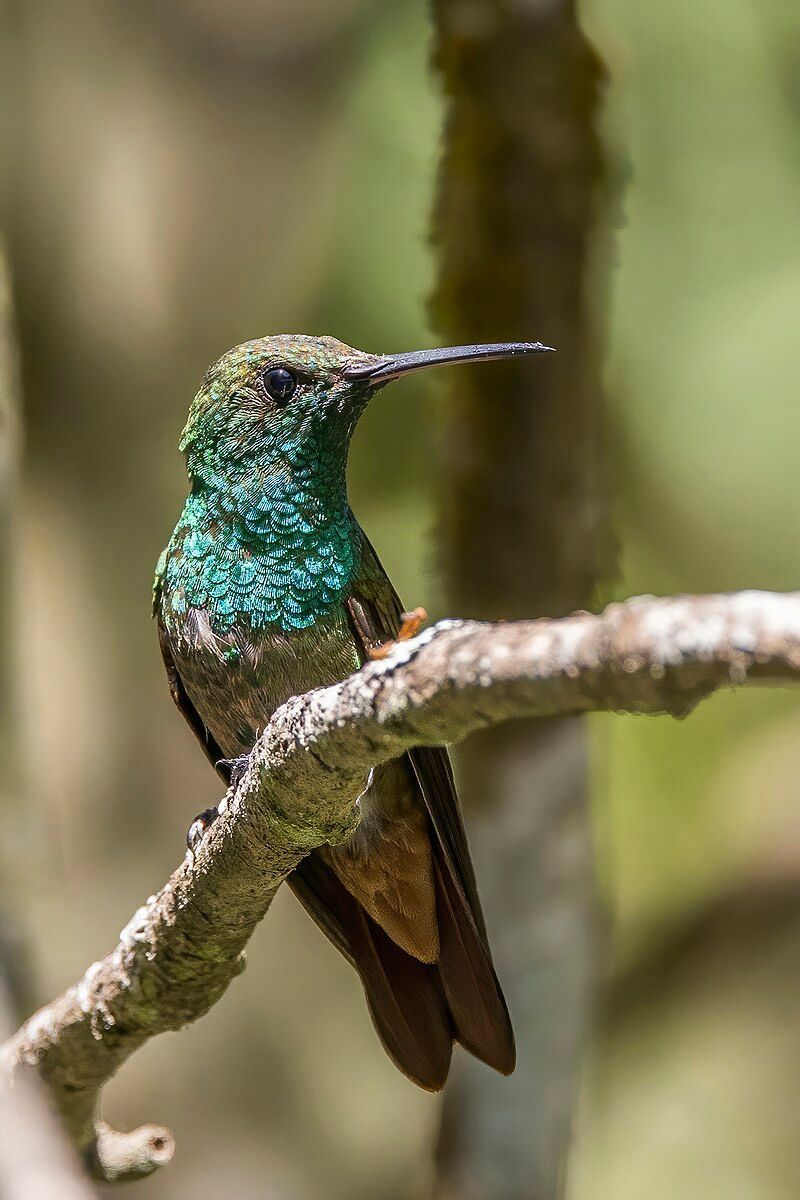
The berylline hummingbird is a hummingbird species in the Trochilini tribe of the Trochilinae subfamily. This species can be found in El Salvador, Guatemala, Honduras, Mexico, and the United States.
It is called an “emerald” because of its iridescent green plumage. This hummingbird species is small, with a body length between 8-9 cm and a wingspan of up to 11 cm. It has a long, slender bill, usually a bright green.
Its tail is forked and iridescent. The berylline hummingbird is a nectar-feeder known for its acrobatic flying abilities. It typically feeds on the nectar of flowering plants, but it also eats small insects and spiders.
The species is relatively common and not considered threatened or endangered.
| Kingdom | Animalia |
| Phylum | Chordata |
| Clade | Strisores |
| Class | Aves |
| Order | Apodiformes |
| Family | Trochilidae |
| Genus | Saucerottia |
| Species | S. beryllina |
12. Mexican Violetear
The Mexican Violetear is a striking species of hummingbird found in the forests of Mexico, Guatemala, Honduras, and Nicaragua. This species is typically metallic green in color, with a medium-sized body.
Its vibrant green coloring makes it easily distinguishable from other hummingbird species. The Mexican Violetear was once believed to be part of the same species as the lesser Violetear and was commonly referred to as the Green Violetear.
This was because they shared many of the same characteristics. However, further research revealed that the two species are indeed separate and have since been classified as two distinct species.
The Mexican Violetear tends to inhabit more humid and dense forested areas, whereas the lesser Violetear is known to venture into more open spaces. They both feed mainly on nectar, pollen, and insects, and they can often be seen hovering around flowers.
In addition, they also have similar breeding habits, such as mating and nesting in tree cavities.
Overall, the Mexican Violetear is a beautiful and interesting species of hummingbird known for its vibrant green coloration and its presence in the forests of Central America.
It is closely related to the lesser Violetear but is now considered a separate species.
| Kingdom | Animalia |
| Phylum | Chordata |
| Clade | Strisores |
| Class | Aves |
| Order | Apodiformes |
| Family | Trochilidae |
| Genus | Colibri |
| Species | C. thalassinus |
13. White-Eared Hummingbird
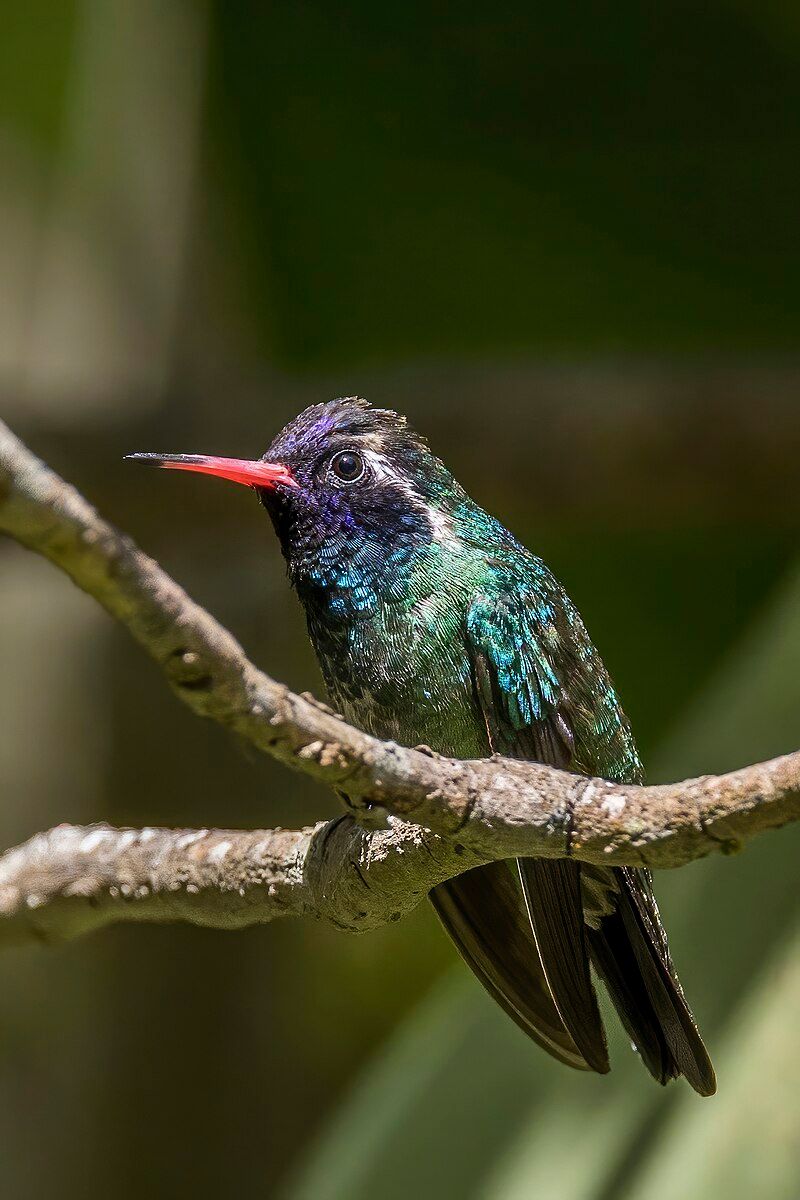
The white-eared hummingbird is a species of hummingbird that belongs to the Trochilini tribe of the Trochilinae subfamily. It is native to the southwestern United States, stretching from Arizona to Texas and extending as far south as Nicaragua.
This hummingbird species is characterized by its white ear patch, visible in both males and females. The white-eared hummingbird is a small bird, measuring only 4 inches long and weighing only 0.1 ounces. It has a long, slightly curved bill and a short tail.
Its plumage is predominantly green with white markings on its throat and sides. This hummingbird species feeds on small insects and nectar from various flowers. It is a social bird, often gathering to feed or rest in groups.
Its song is a rapid series of high-pitched chirps. The white-eared hummingbird is an important pollinator of the habitats it inhabits, playing an important role in maintaining the biodiversity of its habitats.
| Kingdom | Animalia |
| Phylum | Chordata |
| Clade | Strisores |
| Class | Aves |
| Order | Apodiformes |
| Family | Trochilidae |
| Genus | Basilinna |
| Species | B. leucotis |
14. Broad-Billed Hummingbird

The broad-billed hummingbird is a small-sized bird that is native to Mexico and the southwestern United States. Its bright plumage and broad, bright red bill are distinctive features of this species.
The bird also displays sexual dimorphism, where the male and female adults look different. The juveniles of this species are more similar in appearance to the female adult than the male adult. The broad-billed hummingbird is a very vibrant and colorful bird.
It has a bright green back and head, an orange throat and chest, a greyish-white belly, and bright blue wings and tail feathers. The most distinctive feature of this species is its bright red bill, which is broad and slightly curved at the tip.
The bright plumage of the broad-billed hummingbird is unique and easily distinguishes it from other hummingbird species. The sexual dimorphism of the broad-billed hummingbird is also quite remarkable.
The male adult has a bright metallic green head, while the female adult has a brownish-grey head. In addition, the male adult has a more curved and colorful bill than the female adult.
The juveniles of this species also have a brownish-grey head and a less curved bill, which are more similar to the female adult than the male adult. Overall, the broad-billed hummingbird is an impressive species of hummingbird.
It is a small-sized bird with a unique bright plumage and bright red bill. It also displays sexual dimorphism, where the juveniles resemble the female adult more than the male adult.
This hummingbird species is a beautiful sight; its vibrant colors make it a joy to watch.
| Kingdom | Animalia |
| Phylum | Chordata |
| Clade | Strisores |
| Class | Aves |
| Order | Apodiformes |
| Family | Trochilidae |
| Genus | Cynanthus |
| Species | C. latirostris |
15. Hooded Warbler
The Hooded Warbler is a species of bird native to North America. It breeds across the eastern United States and Canada and then migrates south to Central America and the West Indies for the winter.
The Hooded Warbler is a rare sight in Western Europe, only appearing as a vagrant on rare occasions. The Hooded Warbler is a New World Warbler family member, including over fifty bird species.
These birds are typically found across the Americas, known for their colorful plumage and beautiful songs. The Hooded Warbler is an olive-green bird with yellow streaking along its wings and a black hood on its head.
It has white patches on its throat and sides, and its bill is slightly curved. The Hooded Warbler is one of the only warblers with a distinct breeding territory. It prefers open woodlands, such as oak and hickory forests, and is shy.
It is a solitary bird and can often be found foraging on the ground for insects and spiders. The Hooded Warbler nests in shrubs or low trees, usually near water sources. The Hooded Warbler is important to the eastern United States and Canada ecology.
It helps keep insect populations in check, and its beautiful songs add beauty to the forests. Its migratory patterns also help spread nutrients and beneficial organisms throughout the Americas.
Although it is rare to see the Hooded Warbler in Western Europe, its presence is a reminder of the beauty and importance of these birds.
| Kingdom | Animalia |
| Phylum | Chordata |
| Clade | Dinosauria |
| Class | Aves |
| Order | Passeriformes |
| Family | Parulidae |
| Genus | Setophaga |
| Species | S. citrina |
16. Costa’s Hummingbird
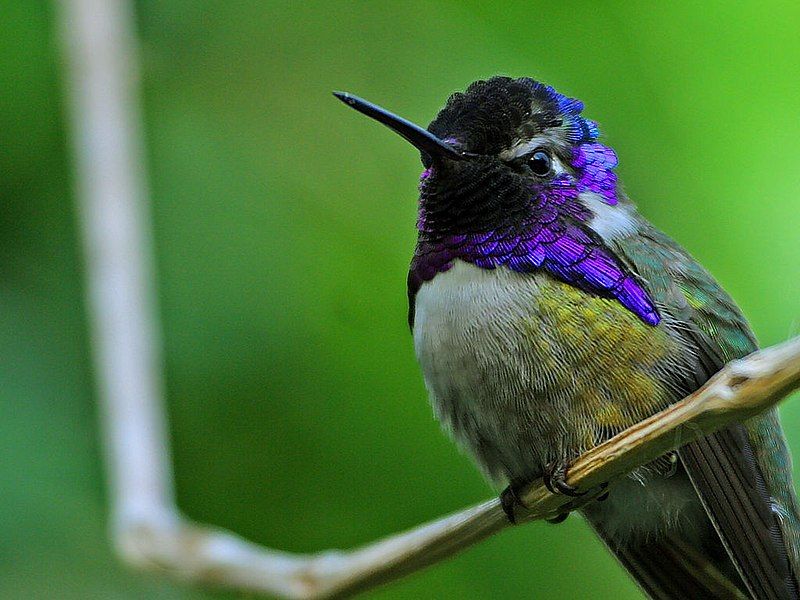
Costa’s Hummingbird is one of the many species within the hummingbird family Trochilidae. This species is found in the arid regions of the southwestern United States and northwestern Mexico. During the winter months, it can be found in western Mexico.
This hummingbird species is highly adapted to its dry, arid environment. It has long wings and a fast, hovering flight that allows it to cover large distances in search of food and shelter.
The plumage of the Costa’s Hummingbird is mostly green, but its head and throat can be a bright iridescent magenta or purple. This hummingbird species typically feeds on the nectar of flowers, but it also eats small insects and spiders.
During the breeding season, males establish and defend a territory while the females build nests and raise their young. The Costa Hummingbird is a remarkable species, and its ability to thrive in arid habitats is a testament to its resilience.
| Kingdom | Animalia |
| Phylum | Chordata |
| Clade | Strisores |
| Class | Aves |
| Order | Apodiformes |
| Family | Trochilidae |
| Genus | Calypte |
| Species | C. costae |
Conclusion
Green birds in Michigan are a wonderful and diverse group of species. From the brightly colored Northern Cardinals to the more subtlely plumed warblers, each species adds a unique beauty to the state’s avian population.
With suitable habitats, green birds can be found in most parts of Michigan, providing various opportunities for both bird watchers and nature lovers.
With the protection of green birds in Michigan, these species can continue to thrive and bring joy to birders and non-birders alike.